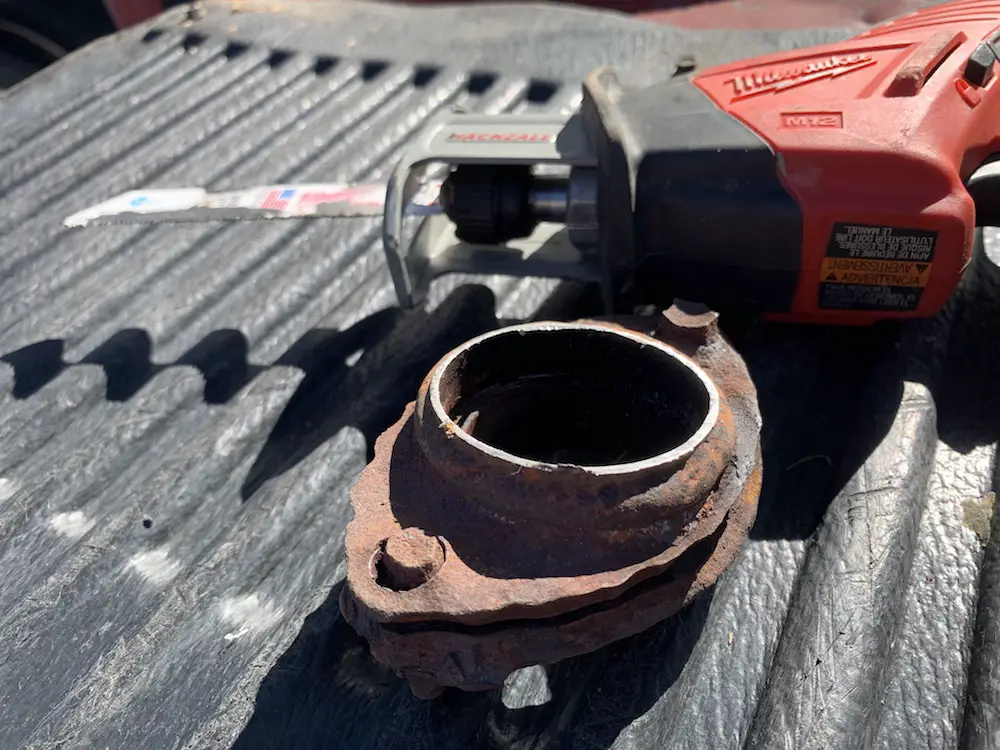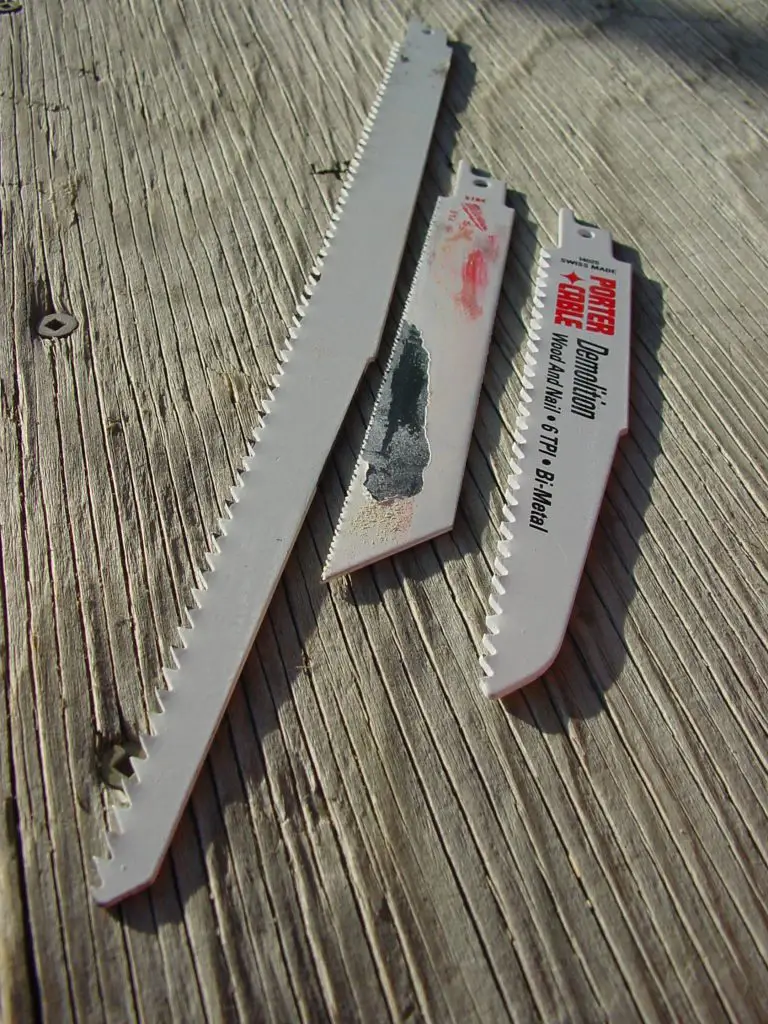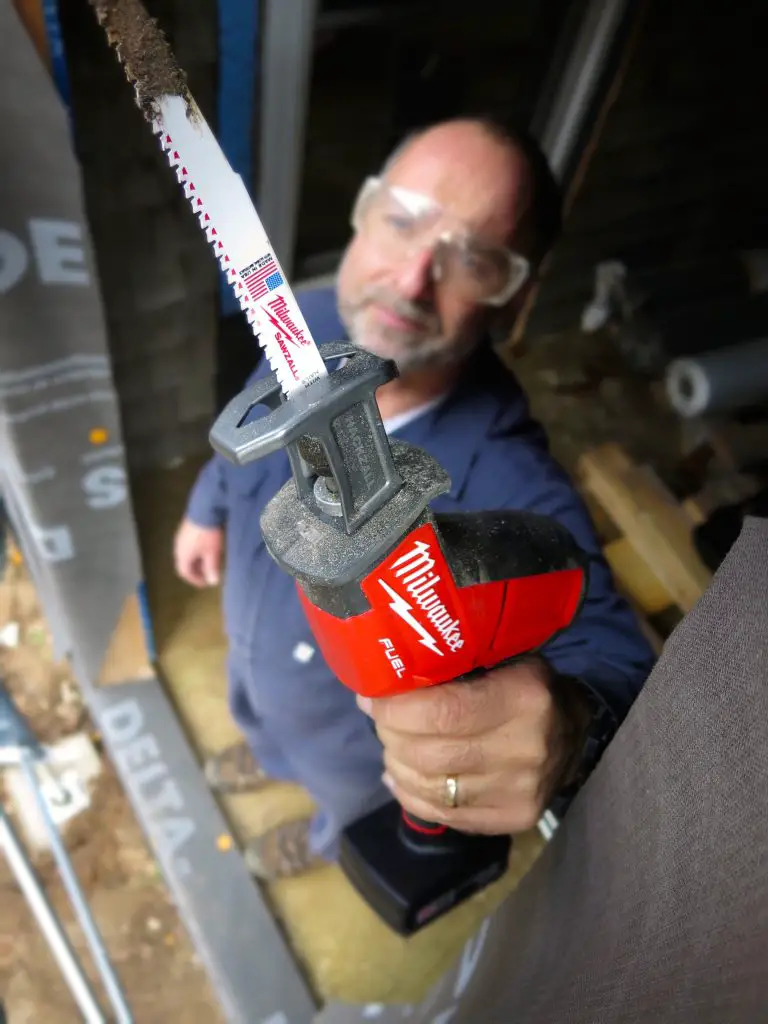That’s me holding a small, 12-volt cordless reciprocating saw. Both blades and the saws themselves have gotten a lot better over the last 10 years.
- Reading Time = 6 minutes
- Video#1 Watch Time = 14 1/2 minutes
If you’ve got home renovations on your to-do list (and maybe even auto repairs), then you should probably know more about reciprocating saws. Professionals use them all the time for gutting old spaces, and you should too if you plan to take on any serious renovation work. I use my reciprocating saw quite often for auto repairs, too. With the right blade you can easily cut through rusted exhaust pipes better and more cleanly than a torch. Let me show you what I mean.
What is a Reciprocating Saw Good For?
Although these tools are called “reciprocating saws” in the trade, a better term might be “precision demolition saw”. No other piece of equipment let’s you slip in and slice out old metal, wood and plaster as easily and with so little collateral damage. And that’s good because clean, efficient initial surgery is the best way to lay the groundwork for new walls, built-ins, windows, doors and other improvements that boost home comfort and value.
Reciprocating saws are like modified, fortified, specialized jigsaws. They include a relatively small working foot with a large hungry blade sticking out the end, and a long, narrow motor tucked behind. The design looks like a little jack hammer — just the ticket for reaching into places inaccessible with other power saws. And some refinements in leading models improve stealth capacity even more by including articulated joints that allow you to snake into a work zone around corners and through tight spots.

A reciprocating is ideal for cutting out old sections of auto exhaust pipe for repairs right in your driveway. The last time I had an exhaust leak develop on one of my vehicles I had it fixed in less time than it would take me to drive to an auto garage, and the repair cost about $10 in materials. A reciprocating saw is the ideal tool to help with work like this, cutting out the old section of bad pipe. That’s what you see above. The video below shows a neat trick I use for repairing an exhaust pipe when you can’t pull neighbouring pieces of pipe apart to slip in a new piece of pipe.
How Thick of Wood Can a Reciprocating Saw Cut?
Typical maximum thicknesses are 1 1/2″ to 2″ thick. That said, you can buy course blades for reciprocating saws that allow pruning of branches up to about 3″ thick. It’s quite useful.
Whether you’re considering buying or renting a recip saw, there are two must-have features you should look for: variable motor speed and orbital blade action. Not all models offer both these capabilities, so look carefully. Variable speed lets you slow down or speed up blade motion, tailoring the motor speed to the material and the blade involved. A coarse blade, for instance, runs best through old framing lumber flat-out, while a slow-moving fine-tooth blade is what you need to cut through old galvanized steel water pipes, for example.
Variable speed is valuable in any recip saw because of the diversity of tasks it allows. And all else being equal, a motor controlled by a variable speed dial or trigger is better than one that has just low and high speeds. The ability to slow down cuts in metal is an especially good way to extend blade life. Orbital blade action is another huge advantage, as you’ll see next.

Why You Need Orbital Blade Action
Picture this . . . you’re standing on a step ladder, cutting above your head while old lath, plaster and 2×8 slices rain down around you. That’s what you might encounter installing a skylight, for instance, and it’s the kind of tough job that any good recip saw can handle.
But what about your arms? With all that muscle strain going on, the faster the cut happens the better. And supercharged cutting speed is what something called “orbital blade action” offers.
By driving the blade in a D-shaped pattern (down along the straight back of the D, and upwards along the curved front), the cutting rate becomes two or three times faster compared with ordinary up-and-down blade motion. The drawback is a somewhat rougher cut, but that’s rarely a problem with the kind of work that recip saws are made for. After all, the are made for rough work. And for those rare times when you really need a smooth cut edge, simply deactivate orbital action and you’ll get smoother (albeit slower) cuts.

Jigsaw Or Recip saw?
Both jigsaws and reciprocating saws have blades that move back and forth, but the main differences are blade size and tool shape. A jigsaw is designed to cut curved shapes in pieces of material, typically wood. The jigsaw sits on the wood and slides around to make the cut. Reciprocating saws, by contrast, have blades that are typically longer. These tools are meant to make cuts in all positions and in many materials, especially irregularly shaped things such as pipes, framing members, and even rusty old auto parts.
Most major home renovations seem to involve cutting out old pieces of wood, but that doesn’t mean you won’t encounter metal. In fact, you almost certainly will in time. Wall and ceiling frames all bristle with hidden nails, and that’s why even so-called wood-grade recip saw blades are actually tough enough to encounter the occasional nail and win. But even still, consider picking up some made-for-metal blades when you stock up for a job. They have the fine teeth of a hacksaw blade and offer one of the neatest methods for dismantling old wooden framing members. Instead of cutting the wood or bashing and smashing it, slice into wood joints and cut the nails only. The frame members will now come apart easily, leaving you a neater work area and better pieces of wood you can reuse for your renovations.
Can a Reciprocating Saw Cut Straight?
No, not really. Since the straightness of a cut is entirely dependent on how consistently you hold the tool, straightness is up to the tool user. That said, use a tablesaw or a hand-held circular saw with a guide if you want straight cuts. Recip saws are not about precision.
The homeowners I see who succeed at DIY renovations all share one attribute. They take the time to prepare themselves properly beforehand, embracing no excuses about why something has to be tackled with substandard materials, insufficient planning or inadequate tools. The reciprocating saw is one tool that might be easily missed as you gear up for a home improvement campaign. But remember it just once and you’ll never forget again.
Click below to watch a video review I did on one of my favourite small, cordless reciprocating saws when it first came out.
Did you find this article useful? I hope so. Please consider helping with content creation and publication by “buying me a coffee” by clicking the button below. It’s fast, safe and much appreciated. Thank you to everyone who has been helping out so far.
– Steve Maxwell




